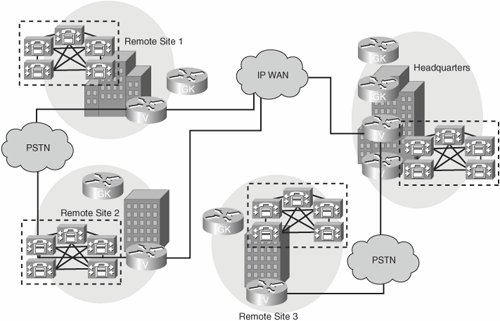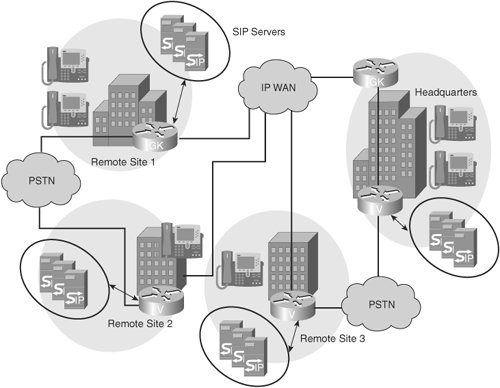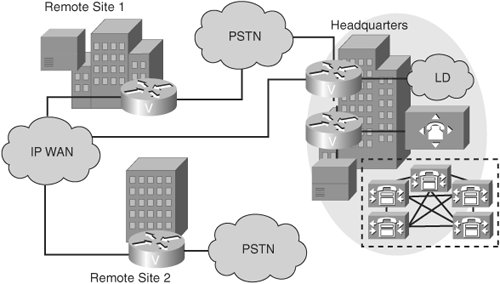Comparing Call Control Models
| Understanding the capabilities of the H.323, SIP, and MGCP models helps you decide which call control model best meets your requirements. This section compares the features and functions of the three call control models. This section also highlights the environments for which each call control model is best suited. Call Control Model Feature ComparisonIn a generic model, the components of signaling and call control are identified as common control components and endpoints. Common control components provide a set of optional services: call administration and accounting, call status, address management, and admission control. Table 6-1 identifies how the basic components of the generic model are configured in H.323, SIP, and MGCP, and, if applicable, where optional services are provided.
As a design aid, Table 6-2 compares several factors that can influence your decision to select H.323, SIP, or MGCP.
Note As of version 3 of H.323, the call signaling channel and the H.245 control channel can operate over UDP. The following sections describe the call control protocol characteristics identified in Table 6-2. Standards Body: ITU-T or IETFThe two originating authorities for the model might seem to have little relevance. However, the ITU-T and the IETF work under different conditions, a fact which impacts the results and the speed of their work. Although the ITU-T is older than the IETF, its associated publishing cycle and consensus process is often blamed for delay. However, its rigorous procedures result in mature recommendations with consistent use of language and terminology. The consensus process requires a high level of agreement and is generally accepted as the preferred way to proceed internationally. Without being subject to the rigors of the ITU-T's procedures and policies, the IETF can respond quickly to user demands, although the solutions can be less mature than those created by the ITU-T. Knowing which standards body is involved provides a sense of the standards development process, the pace of work, and the quality of results. Architecture: Centralized or DistributedThe distinction between the centralized architecture and the distributed architecture can influence which model you choose. For example, a design that had call routing intelligence located at a central location might benefit from the centralized architecture. Current VersionThe current version of a specification or recommendation is an indication of the specification's maturity. For example, H.323 is currently in version 4, which provides some indication as to its level of maturity, as compared to other protocols. For example, SIP is currently at version 2.0, and MGCP is at version 1.0. Signaling Transport: TCP or UDPUnderstanding the underlying transport of the signaling channels helps to explain the relationship among H.323, SIP, or MGCP components. Connectionless, UDP-based relationships must shift reliability and sequencing into the application, making them more complex. Both reliability and sequencing are built into TCP. However, UDP-based applications are designed to respond more quickly than TCP-based applications. This speed is significant, for example, during call setup. Call Control Encoding: ASN.1 or TextTraditionally, the ITU-T and the IETF have proposed different methods of encoding information that travels between endpoints. It is generally accepted that applications using text-based encoding are easier to encode, decode, and troubleshoot, compared to ASN.1-based encoding, which is more compact and efficient. Supplementary Services: Endpoint or Call ControlWhere and how you introduce supplementary services (for example, hold, transfer, and conferencing services) can be important considerations in a comparison of H.323, SIP, or MGCP. Services deployed throughout the network are easily implemented centrally in a call control component. Services with regional relevance can be implemented effectively in the endpoints. Strengths of H.323, SIP, and MGCPBecause there are several different telecommunication environments, more than one choice for signaling and call control is necessary. This section describes some of the strengths of the call control models discussed in this chapter. H.323H.323, which was the only viable option in VoIP signaling and call control solutions for a long period of time, is mature and attracts supporters. Consequently, H.323 products are widely available and deployed extensively. When properly designed, H.323 is both scalable (accommodates the implementation of large distributed networks) and adaptable (allows for the introduction of new features). The H.323 call control model works well for large enterprises because gatekeeper-centralized call control provides some capability for Operation, Administration, and Maintenance (OA&M). SIPSIP is a multimedia protocol that uses the architecture and messages found in popular Internet applications. By using a distributed architecture, with URLs for naming, and text-based messaging, SIP takes advantage of the Internet model for building VoIP networks and applications. SIP is used in a distributed architecture and allows companies to build large-scale networks that are scalable, resilient, and redundant. SIP provides mechanisms for interconnecting with other VoIP networks and for adding intelligence and new features on the endpoints, SIP proxy, or redirect servers. Although the IETF is progressive in defining extensions that allow SIP to work with legacy voice networks, the primary motivation behind SIP is to create an environment supporting next-generation communication models that utilize the Internet and Internet applications. In addition, the lack of centralized management support makes SIP more suitable for growing, dynamic organizations and Internet telephony service providers. MGCPMGCP describes an architecture in which call control and services such as OA&M are centrally added to a VoIP network. As a result, MGCP architecture closely resembles the existing PSTN architecture and services. In a centralized architecture, MGCP allows companies to build large-scale networks that are scalable, resilient, and redundant. MGCP provides mechanisms for interconnecting with other VoIP networks and adding intelligence and features to the call agent. MGCP works well for organizations that are comfortable with centralized management and control. For example, service providers are well suited for MGCP. Selecting Appropriate Call ControlCall control selection takes into account corporate policy and business requirements. Consider some of the major design requirements for MGCP, H.323, and SIP. H.323 Call Control ModelThe H.323 call control model is used where there is a strong requirement for mature standards with distributed call-logic functionality. Figure 6-50 illustrates a topology using the H.323 call control model. Figure 6-50. H.323 Call Control Solution The H.323 call control model has the following design characteristics:
SIP Call Control ModelThe SIP call control model is used where there is a strong requirement for innovative services and application deployment with distributed call-logic functionality. Figure 6-51 illustrates a topology using the SIP call control model. Figure 6-51. SIP Call Control Solution The SIP call control model has the following design characteristics:
MGCP Call Control ModelThe MGCP call control model is used where there is a strong requirement for centralized control. Figure 6-52 illustrates a topology using the MGCP call control model. Figure 6-52. MGCP Call Control Solution The MGCP call control model has the following design characteristics:
|
EAN: 2147483647
Pages: 111